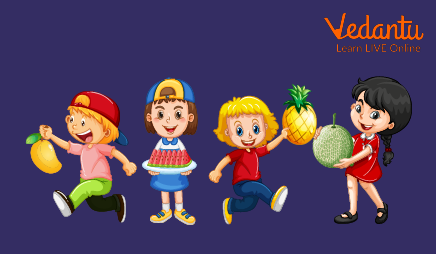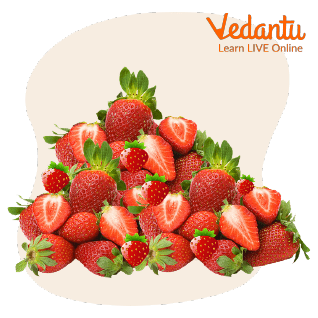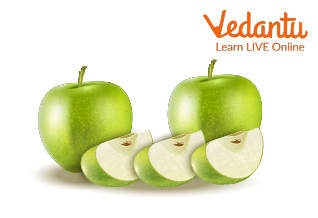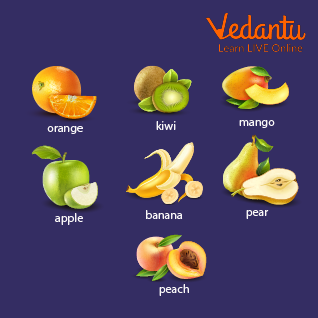




Why Are Fruits Important? Explore Names, Benefits & Exciting Facts
The fruits are part of a flowering plant containing seeds. The fruits develop from a flower of the plant. The fruit's outer layer, called the fruit's skin, may be thin, tough, or hard. The matter present in the fruit is sweet and juicy. Some fruits are dry from inside and out.
Some vegetables are fruits, but these are fruits. For example, people call cucumbers, squashes, and tomatoes vegetables, but these are all fruits. The fruits contain seeds, while the true vegetables are not seeds. True vegetables are stems, leaves, or roots of plants.

Kids Holding Fruits
Fruits Names for Kids
The fruits names for kids are given as follows:
1. Lemons: Lemons are a citrus fruit that people often use in traditional remedies since they have so many health benefits. They contain vitamin C and other antioxidants.

Lemons
2. Strawberries: The strawberries are red-coloured juicy fruit. It contains a high water content. Strawberries contain so many healthful vitamins and minerals. The seeds of strawberries provide plenty of dietary fibre per serving.

Strawberries
3. Oranges: The oranges are sweet, round citrus fruit packed with so many vitamins and minerals. The oranges are the fruit that are the richest sources of vitamin C. Vitamin C acts as a powerful antioxidant in the body.

Oranges
5. Blackberries: The blackberries contain many seeds, so they have a high fibre content. This means they help improve gut health and heart health.

Blackberries
6. Apples: Apples are the options to make a quick and easy addition to the diet. Apples are high in fibre means eating them could boost heart health and promote weight loss. Eating apples with the skin on gives the greatest health benefits.

Apples
Fruits Images for Kids
The following picture shows the fruit images for kids.
In the following picture, you can see different fruits like apples, bananas, oranges, grapes, strawberries, watermelon, pineapple, and cherry.

Different Types of Fruits
Fun Facts
Some fun facts about fruits are mentioned below:
Mainly there are two types of fruit: fleshy fruits and dry fruits.
The fleshy fruits are those in which the part of the fruit around the seeds is juicy and soft. Example: Apples, berries, oranges, and other fleshy fruits contain many seeds.
The dry fruits are not as juicy as the fleshy fruits. The dry fruits include beans and nuts.
All of us and many wild animals enjoy eating fresh fruits. Fruits are very important sources of fibre and vitamins, especially vitamin C.
Fruits contain minerals and plenty of water.
People also enjoy eating frozen, canned, and dried fruits. They convert fruits into jams and jellies.
The fruits are also added to a variety of desserts and main dishes. People also drink juices or fruits.
Summary
The fruits are available in all shapes and sizes, and different fruits have different health benefits. For the best results, add a variety of fruits to the diet. By eating fruit, a person is giving their body key vitamins, antioxidants, and so much dietary fibre. This can significantly benefit heart health, digestion, weight management, and skin health. People can enjoy a wide range of fruits to improve their health and can lower the risk of inflammation, heart disease, cancer, obesity, and diabetes.
FAQs on Fruit Names for Kids: Pictures, Types & Fun Facts
1. What exactly is a fruit, in simple terms?
A fruit is the part of a flowering plant that contains seeds. It grows on the plant and is often sweet and juicy, designed to be eaten. Think of an apple with its tiny seeds inside, or a mango with its big, single seed. We eat fruits to get energy and stay healthy.
2. Why is it important for kids to eat fruits?
It is very important for kids to eat fruits because they are packed with essential vitamins, minerals, and fibre. These nutrients help you grow strong, give you energy to play, and protect your body from getting sick. Eating fruits every day helps keep your tummy working well and your skin healthy.
3. What are some common and healthy fruits for kids?
Many fruits are great for kids! Some of the most common and healthy examples include:
- Apples: Crunchy and good for your teeth.
- Bananas: Give you quick energy for playing.
- Oranges: Full of Vitamin C to help you fight colds.
- Grapes: Small, sweet, and easy to eat (always cut them for young children).
- Strawberries and Blueberries: Yummy berries that act like nature's healthy candy.
- Mangoes: The sweet and juicy fruit often called the "king of fruits".
4. What is the difference between a fruit and a vegetable?
The main scientific difference lies in which part of the plant they come from. A fruit develops from the flower of a plant and contains seeds (like apples, tomatoes, and cucumbers). In contrast, a vegetable is any other edible part of the plant, such as the leaves (spinach), roots (carrots), or stems (celery). While we often group them by taste in the kitchen, this is the botanical distinction.
5. Why are some fruits sweet while others are sour?
The taste of a fruit depends on the balance of its natural sugars and acids. Fruits taste sweet because they contain sugars like fructose and glucose. As a fruit ripens, it produces more sugar. Sour fruits, like lemons and raw mangoes, have a higher concentration of natural acids (like citric acid) than sugar. This balance gives each fruit its unique flavour.
6. How does eating fruits help us from getting sick?
Fruits are like little shields for your body. They are filled with special nutrients called vitamins (especially Vitamin C) and antioxidants. These nutrients help build and strengthen your body's defence system, known as the immune system. A strong immune system can effectively fight off germs and viruses that cause common illnesses like colds and coughs.
7. Do all fruits have seeds?
Scientifically, for something to be classified as a fruit, it must develop from the flower and contain seeds. However, through special farming methods, humans have developed seedless varieties of some fruits to make them easier to eat. That's why you can find seedless grapes, watermelons, and bananas, even though their wild ancestors had seeds.
8. Is it better to eat a whole fruit or drink fruit juice?
It is always better to eat a whole fruit. When a fruit is squeezed into juice, it loses a very important component called fibre. Fibre is crucial for good digestion, preventing constipation, and making you feel full and satisfied. Whole fruits provide a complete package of vitamins, minerals, and essential fibre, making them a much healthier choice than fruit juice, which is often high in sugar and lacks fibre.
9. Why do fruits have different colours, like red, yellow, and green?
The vibrant colours of fruits come from natural pigments, which are not just for show; they indicate the presence of different healthy nutrients. For example:
- Red fruits like strawberries and watermelons contain pigments that are good for heart health.
- Orange and yellow fruits like oranges and mangoes are rich in carotenoids, which are important for good eyesight.
- Green fruits like kiwis and green grapes contain nutrients that help build strong bones and teeth.





















